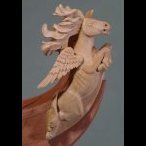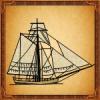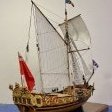-
Posts
8,149 -
Joined
-
Last visited
Reputation Activity
-
 allanyed got a reaction from avsjerome2003 in Brook in the book "The Naval Cutter Alert" by P. Goodwin
allanyed got a reaction from avsjerome2003 in Brook in the book "The Naval Cutter Alert" by P. Goodwin
Robert,
The breech rope does appear that it will cause the rings to flip and jam the rope. It is also highly unlikely that the running tackle on cannon on a cutter, would have a double and single block on each side. Two singles on each side were the norm except on 32 pounders according to the History of British Sea Ordinance 1523 to 1875 Volume II, by Adriana Caruana.
Allan
-
 allanyed got a reaction from druxey in Brook in the book "The Naval Cutter Alert" by P. Goodwin
allanyed got a reaction from druxey in Brook in the book "The Naval Cutter Alert" by P. Goodwin
Robert,
The breech rope does appear that it will cause the rings to flip and jam the rope. It is also highly unlikely that the running tackle on cannon on a cutter, would have a double and single block on each side. Two singles on each side were the norm except on 32 pounders according to the History of British Sea Ordinance 1523 to 1875 Volume II, by Adriana Caruana.
Allan
-
 allanyed got a reaction from WackoWolf in Hawse Bucklers
allanyed got a reaction from WackoWolf in Hawse Bucklers
Further to Gary's post, these were called half bucklers and blind bucklers, the latter of which fully closed off the hawse hole inboard on British ships, at least in the 18th century and into the 19th century. There may have been other methods, but this seems to have been at least one common method of keeping out the water. The manger was present as well to help contain water (and mud, when the hawsers were brought in when raising the anchor) There were relatively large scuppers in this area of the manger as well to let the water run off.
Allan
-
 allanyed got a reaction from Trussben in HMS Blanche 1800 by robbl - 1/48 - POF - was HMS Euryalus 1803
allanyed got a reaction from Trussben in HMS Blanche 1800 by robbl - 1/48 - POF - was HMS Euryalus 1803
Rob,
When you get to that transom, fire away with the questions. I am sure Wayne or I will be able to help, at least I hope so.
Another book??? I swore never again, but........
Allan
-
 allanyed got a reaction from WackoWolf in Making cannons from non-traditional materials
allanyed got a reaction from WackoWolf in Making cannons from non-traditional materials
Sherry,
You can try to contact Polytek (www.polytek.com) and/or look at some of their Youtube videos. We use several of their RTVs for making molds for our automated lipstick molding machines, and I also have purchased RTV's and casting resins from them in their Easy Flo line of products. Great stuff.
Allan
-
 allanyed got a reaction from newbuilder101 in Making cannons from non-traditional materials
allanyed got a reaction from newbuilder101 in Making cannons from non-traditional materials
Sherry,
You can try to contact Polytek (www.polytek.com) and/or look at some of their Youtube videos. We use several of their RTVs for making molds for our automated lipstick molding machines, and I also have purchased RTV's and casting resins from them in their Easy Flo line of products. Great stuff.
Allan
-
 allanyed got a reaction from WackoWolf in Second Layer Planking Guide
allanyed got a reaction from WackoWolf in Second Layer Planking Guide
Hello Baris,
Properly spiled planks can be soaked and pre-bent and dried before gluing to the model. If this is done, they can be held with the fingers for a minute or less while the glues starts to set.(aliphatic glue). There is no need for pinning. That said, making perfectly spiled planks is not always possible if only using strips of wood such as come in kits rather than cutting from sheet stock as mentioned by Chuck. A number of planking clamp designs have been shown on this site including many by Ed Tosti in his Naiad build log (and books.) They eliminate the need for using pins.
Allan
-
 allanyed got a reaction from druxey in Anyone ever cast their own cannon?
allanyed got a reaction from druxey in Anyone ever cast their own cannon?
I cannot seem to be able to copy and paste the write up, but have posted some photos of a single piece molding process in the meantime.
Allan
-
 allanyed got a reaction from janos in Anyone ever cast their own cannon?
allanyed got a reaction from janos in Anyone ever cast their own cannon?
I cannot seem to be able to copy and paste the write up, but have posted some photos of a single piece molding process in the meantime.
Allan
-
 allanyed got a reaction from Krutzelpuntz in Anyone ever cast their own cannon?
allanyed got a reaction from Krutzelpuntz in Anyone ever cast their own cannon?
I cannot seem to be able to copy and paste the write up, but have posted some photos of a single piece molding process in the meantime.
Allan
-
 allanyed got a reaction from WackoWolf in Anyone ever cast their own cannon?
allanyed got a reaction from WackoWolf in Anyone ever cast their own cannon?
I cannot seem to be able to copy and paste the write up, but have posted some photos of a single piece molding process in the meantime.
Allan
-
 allanyed got a reaction from Q A's Revenge in Anyone ever cast their own cannon?
allanyed got a reaction from Q A's Revenge in Anyone ever cast their own cannon?
I cannot seem to be able to copy and paste the write up, but have posted some photos of a single piece molding process in the meantime.
Allan
-
 allanyed got a reaction from mtaylor in Anyone ever cast their own cannon?
allanyed got a reaction from mtaylor in Anyone ever cast their own cannon?
I cannot seem to be able to copy and paste the write up, but have posted some photos of a single piece molding process in the meantime.
Allan
-
 allanyed got a reaction from catopower in Anyone ever cast their own cannon?
allanyed got a reaction from catopower in Anyone ever cast their own cannon?
I cannot seem to be able to copy and paste the write up, but have posted some photos of a single piece molding process in the meantime.
Allan
-
 allanyed got a reaction from NMBROOK in Anyone ever cast their own cannon?
allanyed got a reaction from NMBROOK in Anyone ever cast their own cannon?
I have gone to making and using a single piece mold and eliminated the seam and vents. Works very well for casting resin or pewter. I will try to post details and pics tonight
Allan
-
 allanyed got a reaction from WackoWolf in Anyone ever cast their own cannon?
allanyed got a reaction from WackoWolf in Anyone ever cast their own cannon?
I have gone to making and using a single piece mold and eliminated the seam and vents. Works very well for casting resin or pewter. I will try to post details and pics tonight
Allan
-
 allanyed got a reaction from billocrates in Young America 1853 by EdT - FINISHED - extreme clipper
allanyed got a reaction from billocrates in Young America 1853 by EdT - FINISHED - extreme clipper
Ed,
I do like the idea of the monofilament. Any problem with the ends being too shiny?
Regarding the tinted glue, is there a reason you choose to use the powdered pigment versus a liquid acrylic paint? I have used the latter with no ill effects. It does not take much paint to tint the glue if using a good professional artist color that is heavily pigmented so there are not worries of "weak" glue. The first time I tried it I did test pieces and the wood broke away before the seam.
Thanks
Allan
-
 allanyed got a reaction from Krutzelpuntz in 6-pound & 4 pound cannon measurements
allanyed got a reaction from Krutzelpuntz in 6-pound & 4 pound cannon measurements
Brian Lavery's book Arming and Fitting British Ships of War has a lot of good information. Adrian Caruana has more, but his books are hard to come by at any price. I believe Lavery has a set of detailed dimensions on a four pounder, but I do not recall if it is right for 1745.
Allan
-
 allanyed got a reaction from dhardy in Young America 1853 by EdT - FINISHED - extreme clipper
allanyed got a reaction from dhardy in Young America 1853 by EdT - FINISHED - extreme clipper
Ed I have never ever thought about building a clipper. I was OK watching your first posts and was enjoying just looking at the great work. But now that the framing is coming along you have gone and messed up my schedule big time as I try to figure if I could juggle my projects to fit in such a project over the next few years.
Great work Ed, on all counts.
Allan
-
 allanyed got a reaction from dhardy in Young America 1853 by EdT - FINISHED - extreme clipper
allanyed got a reaction from dhardy in Young America 1853 by EdT - FINISHED - extreme clipper
Love it!
Allan
-
 allanyed got a reaction from dhardy in Young America 1853 by EdT - FINISHED - extreme clipper
allanyed got a reaction from dhardy in Young America 1853 by EdT - FINISHED - extreme clipper
Ed
You know that this build of yours will take hours away from the rest of our own builds as we keep checking your progress and studying the photos closely. And a big THANK YOU for doing so!!!
Allan
-
 allanyed got a reaction from Elia in Effie M Morrissey 1894 by allanyed - FINISHED - Scale 1:48
allanyed got a reaction from Elia in Effie M Morrissey 1894 by allanyed - FINISHED - Scale 1:48
A bit of progress has taken place. Frames are made and partially faired. Couple strakes have gone on which has beefed up the rigidity of the framing a lot. I did not do much fairing inboard down low as the lower hold is filled with cement for a good portion of the hull. Still debating about putting in the lower deck and cabin details. If I decide to cut out sections of the framing to expose areas inboard, at least the area where the frames are removed will get some finishing work. With Effie having gone through several transitions, her inboard layout also change a lot. I am probably staying with how she orginally came off the ways, so her layout inboard was simpler and certainly more austere than in later modifications. Keel, stem, deadwood, keelson are Castello box, the frames are poplar. Poplar is normally a bit soft for my own taste, but as all the frames are doubled, and the grain is running opposite on each pair, I had no breakage and the fairing has shown them to be pretty nice to work with, so far.
Allan
-
 allanyed got a reaction from Elia in Effie M Morrissey 1894 by allanyed - FINISHED - Scale 1:48
allanyed got a reaction from Elia in Effie M Morrissey 1894 by allanyed - FINISHED - Scale 1:48
I realized that the body plan did not account for the step and deck elevation difference from frame 24 and aft so I modified the body plan and frame drawings. I also found that the clamp for the weather deck beams on the cross section plans at stations 5 and 9 give dimensions of 3"X9" but the individual cross section drawings show two different sizes. I do not know if the given dimensions are correct or the drawn dimensions. To further complicate matters, an expanded view in the cross section plans shows a strake labeled as a sheer strake fayed to the inside of the frames and a clamp fayed to this sheer strake. Neither of these is dimensioned individually and the cross sections do not show this lamination. A drawing of the framing in the forward half the hull does appear to show this lamination.
Several more frames have been raised, so she is starting to take shape. I printed the frame drawings on pressure sensitive label paper, then cut each frame out and place it on the wood. It is then a matter of cutting them out and sanding them close to the lines before peeling off the paper. Brand name label material is a bit expensive, but store brand is much less costly and works the same.
Allan
-
 allanyed got a reaction from Elia in Effie M Morrissey 1894 by allanyed - FINISHED - Scale 1:48
allanyed got a reaction from Elia in Effie M Morrissey 1894 by allanyed - FINISHED - Scale 1:48
I drew the individual frames based on the body plans. First I aligned the profile drawing that shows the station lines with the framing drawing. I could then identify the frame numbers with the station line numbers which otherwise had no correlation. I had saved the L ofC drawings in TIF so they had decent resolution and could be inserted into a drawing using TurboCad. Once inserted they were checked and adjusted to be sure they were at the proper scale on the drawing. I used the body plan to draw the frames at the station lines which I assumed are correctly shaped on the drawing. I then divided the space between station line frames for the appropriate number of frames between stations (usually four or two). I realize they would probably not be spaced evenly on the body plan in real life, but at this scale and cutting them a tad heavy, they will fair nicely, using the frames on the station lines as the guides. Besides, it was much easier than drafting each frame using the more traditional, and accurate, methods used by many of our friends here.
The frames are doubled, each being 6 inches wide (12" total width) and moulded 7 ½ inches. Other than at the floors, the moulded dimension does not appear to change, just remains 7 ½” for most of its height. I used 7 ½” circles along the outboard edge of the frame as guide for placing the circles, then drew the inboard edge of the frames "connecting the dots" and maintaining the line parallel to the outboard line. The frames lie on 24-inch centers, thus there is always 12 inches space between the frames.
Rather than building the frames floor and futtock, I used poplar sheets that I planed to 1/8 inch thick. These are glued together with the grain running 90 degrees to each other. Lots of glue, clamps and weights are used to be sure there were no air pockets. Total cost for the wood for the frames was about $35. Had I used Castello boxwood, my favorite, it would have been a much higher cost even if I built the frames futtock by futtock to conserve wood and costs. The doubled frames are still quite strong, even using the softer wood. With the grains running opposite to each other, it easy to see that they are doubled as on the actual vessel. I set the belt sander table to 92 degrees to give the bottom of each frame the angle needed to have them at 90 degrees to the table and account for the 2 degree drag of the keel.
I marked the location of each full frame on the keel while laying the keel on the framing drawing. The drawings give no indication of the use of spacers between the frames at the keel or elsewhere, but I will use them regardless to give support at the keel and a rigid frame work. These are all 1/4X 1/4X 1/8. The drawings show that there is a keelson which will add a lot of support as well. A square is used to be sure the frames are perpendicular to the building board as each is raised.
Hope some of this makes sense.
Allan
-
 allanyed got a reaction from Tony Hunt in Effie M Morrissey 1894 by allanyed - FINISHED - Scale 1:48
allanyed got a reaction from Tony Hunt in Effie M Morrissey 1894 by allanyed - FINISHED - Scale 1:48
I have not personally built nor have I seen a fully framed model of a Grand Banks fishing schooner so I thought it would a fun project to try. There is a lot of information available on the Effie M. Morrissey, including a reasonable set of plans that are available from the Library of Congress, she is available to visit in her modern configuration, and there are folks in Massachusetts that have been more than willing to answer questions, so she seemed to me to be a good choice.
The following is a compilation of her history from the internet, “so it must be true!”
She was designed by George McClain and was the last fishing schooner built for the Wonson Fish Company. She was built with white oak and yellow pine and took four months to complete. She was launched February 1, 1894. Her hull was painted black and her first skipper was William Edward Morrissey, who named her after his daughter Effie Maude Morrissey. She fished out of Gloucester for eleven years then began fishing out of Nova Scotia.
In 1914, ownership moved to Brigus, Newfoundland where Harold Bartlett used her as a fishing and coasting vessel along the Newfoundland and Labrador coasts.
In 1925 Harold Bartlett sold her to his cousin, Captain Bob Bartlett, an Arctic explorer. Bob Bartlett had an auxiliary engine installed and reinforced the hull for use in the Arctic. In 1926 with financial help from publisher George Putnam , Bartlett began 20 years of exploration using the Effie.
When Captain Bartlett passed away in 1946, Effie was sold to the Jackson brothers to carry mail and passengers in an inter-island trade in the South Pacific. On their voyage to the Pacific she developed problems at sea, forcing the crew to return to New York. On December 2, 1947, the boat caught fire while docked at the boat basin in Flushing, New York.
The schooner was repaired and sold to Louisa Mendes in Massachusetts at which time she entered the packet trade in a trans-Atlantic crossing to Cape Verde. Upon reaching the islands, Captain Mendes re-registered the schooner under the name Ernestina, after his own daughter, and used her in inter-island trade. Ernestina made a number of transatlantic voyages and fell into disrepair at Cape Verde, where she remained until the late sixties when there was interest in the U.S. to save her. In 1977 the people of Cape Verde made a gift of Ernestina to the U. S.
In August 1982 her hull was completely rebuilt and she sailed to the United States.
In August 1988 the schooner made a return trip to Brigus, Newfoundland, on the 113th anniversary of Capt. Bob Bartlett’s birth.
Ernestina was designated as a National Historic Landmark i with restoration being completed in 1994, and in 1996 became a part of the New Bedford Whaling National Historical Park. She is currently owned by the Commonwealth of Massachusetts.
Effie is the oldest surviving Banks fishing schooner; the only surviving 19th century Gloucester-built fishing schooner; one of two remaining examples of the Fredonia-style schooners (the other being the Lettie G. Howard,) the only offshore example of that type; and one of two sailing Arctic exploration vessels left afloat in the United States.
This is the fourth model going onto the building board in the attached photos. The model will be based on how she looked in 1894. In the photos you can see that the keel has a piece temporarily attached so it will sit at about a 2 degree angle to match the "drag" and make it easier to check that the frames are 90 degrees to the water lines (building board plane.) I am using Castello box for the keel and deadwood. The plans do not show a shelf along the bearding line of the fore or aft frames. Looking at photos of a rebuild of the schooner Virginia, there are no steps nor shelf. I have no idea if there was one on the original build. More to come, I hope.
Allan














